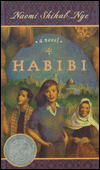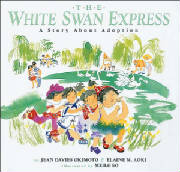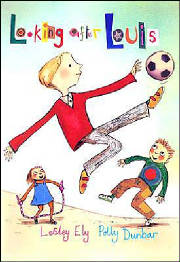|
|
 |
|
Nye, N.S. 1997. Habibi. New York: Simon & Schuster.
ISBN: 0-689-82523-4

Habibi is a novel, written by Naomi Shihab Nye, about a fourteen year old girl that moves with her parents and
younger brother from St. Louis to a home between Jerusalem and the Palestinian village where her father was born. The young
protagonist, named Liyana, explains her heritage; "I’m just a half-half, woman-girl, Arab-American, a mixed breed like
those wild characters that ride up on ponies in the cowboy movies Rafik likes to watch. The half-breeds are always villains
or rescuers, never anybody normal in between." (p.20). Liyana’s father was born in Israel, while her mother, herself,
and brother were born in the United States.
Nye uses numerous cultural markers in this book that include food and tools, such as "hareesa", "maramia", "baklava", and
"taboon". The author also uses many words in Arabic and Hebrew. Usually the other languages are followed by the English translation
such as "Sabah-al-khair- Good Morning" (p.246). Also, Nye confronts the issues in Jerusalem between the Arabs and Jews by
the events of the Israeli soldiers destroying Grandma’s bathroom, a bomb set off in a Jewish marketplace by Palestinians,
and some of Liyana’s family not welcoming her Jewish boyfriend, Omer, to their village.
The title of this book, Habibi, is the arabic word for "darling". The father and grandmother use "Habibi" as a
loving name for male family members. The grandmother’s superstitious beliefs are shown on page 135, when she explains,
"If a bird pooped on a clean white sheet while flying over the clothesline, that meant bad luck. But if it pooped on your
head, that meant your first child would be a boy."
Habibi is a well written novel for young adults that would start conversations between the readers about how different
viewpoints, especially religion, cause conflict. The only negative of this book is that it is shown from the Arabic viewpoint
and there is only one nice Jewish person in this book.
Habibi is a recipient of the Jane Addams Children's Book Award.
Click here to learn more about the Jane Addams Award!!
|
 |
|
Okimoto, J. & Aoki, E. 2002. The White Swan Express. New York: Houghton.
ISBN: 0-618-16453-7

The White Swan Express is a book about adoption. This book tells the story of four different Chinese girls that
are in an orphanage and four different sets of parents that are about to adopt. The families include a single mother from
Minnesota, a heterosexual couple from Miami, a homosexual couple from Seattle, and a heterosexual couple from Toronto. They
all meet each other while in China picking up their daughters and remain in touch by sending holiday cards. There are numerous
Chinese cultural markers in this book. The authors, Jean Davies Okimoto and Elaine M. Aoki use languages of Mandarin and Cantonese,
include cultural heritage such as the silver bracelet with bells for the girls, Chinese holidays, and the families shopping
in the open market.
The illustrator, Meilo So, uses watercolor to portray the characters and scenery in this book. The homosexual couple consists
of a darker skinned woman with short, black hair, and a lighter skin toned woman with red hair. They are drawn a few times
in this book holding hands, but so is the heterosexual couple from Toronto.
The access to literature portraying gay/lesbian characters was limited. The local public library could not keep King
and King or Heather Has Two Mommies on the shelf because of complaints. This book is not specifically about a homosexual
couple, so it has not had as much controversy. Secondly, the homosexual couple look more heterosexual in the illustrations
because one has short hair.
The homosexual couple is not a main part of this story. This book is a beautiful, yet busy, story of the four families
adopting a child. The author explains in the afterword that the Chinese government only lets each family have one child. Therefore,
many children in China are up for adoption. Aoki based this story on her own experience of becoming a family with her adopted
child and husband.
|
 |
|
|
|
Ely, L. 2004. Looking After Louis. Morton Grove, Illinois: Whitman.
ISBN: 0-8075-4746-8

Looking After Louis is written by Lesley Ely and illustrated by Polly Dunbar. This picture book is
about a young boy named Louis that has autism. He is integrated into a regular education classroom and his peers try to understand
Louis’ actions and needs.
Louis has a personal assistant in the classroom, always drawn in the pictures close to him. The cartoon like
pictures depict Louis as being different by everyone else having whites in their eyes and Louis only has black. Cleverly,
the illustrator has drawn many of the general ed peers acting up in class while Louis is not disturbing the classroom. Negatively,
the author and illustrator have only shown that Louis has the tendency of echolaia, the repeating of others’ words,
and no social interaction with others during recess. A high functioning child with autism can finish or at least attempt academic
assignments if given the correct visuals and tools. Realistically, the book shows the compassion and patience that is shown
by the young general ed students towards a child with special needs. Although, Carroll and Rosenblum state in
a recent journal article that the character with the disablity needs to experience the growth himself, not the non-disabled
character. In this book, the growth is seen in the general ed child, not the child with autism.
Looking After Louis does incorporate an innovative practice of mainstreaming in a general classroom
and looking at the feelings of the general ed student in that situation. Hopefully, teachers and children would not read this
book and think that all children with autism act like Louis. This is a good beginning for this topic, but other books are
needed to help facilitate discussions in classrooms.
Carroll, P.S. & Rosenblum, L.P. (2000). Through their eyes: are characters with visual impairment
protrayed realistically in young adult literature? Journal of Adolescent & Adult Literacy, 43 (7), p. 179-185.
READ!READ!READ!
Book covers on this web site are from Barnes and Noble's website at www.bn.com.
|
|
|
 |

